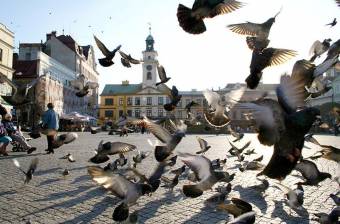Animal life
The animal life in Cieszyn has not been studied extensively. Feeding roe deer (Capreolus capreolus and the European hare (Lepus capensis are a common sight in woodland or on open ground. They are quite often sighted in Lasek Miejski on the Puńcówka, close to the centre of Cieszyn. The badger (Meles meles) is also a resident of Cieszyn’s forests, as is the red squirrel (Sciurus vulgaris), which is also often seen in parks and gardens. It has two colour forms; the light and the dark (characteristic for the mountain variety). Contrary to popular opinion the squirrel does not only eat nuts but also wild mushrooms, berries. It does not turn its nose up at snails or insects, and will even take birds’ eggs and chicks. One can quite often come across the hedgehog (Erinaceus concolor), which frequently falls victim to cars. The mole (Talpa europaea) occurs in large numbers. It is a species under full protection, except when it is tree nurseries, closed gardens and flood defences. Another resident of Cieszyn is the musk-rat (Onclatra zibethicus), which digs long corridors and burrows in river banks. The species was introduced to Europe at the beginning of the 20th century from South America, adapted extremely well and now in certain areas causes serious damage to river defences.
As far as birds are concerned it is worth mentioning the brightly coloured kingfisher (Alcedo athis), which occurs along rivers and streams such as the Olza and Bobrówka, and the grey heron (Ardea cinerea) which can be seen flying above the Olza valley or over fish-farms. The white stork (Ciconia ciconia) has been a visitor to Cieszyn for many years, and individuals have built a nest in each of Krasna and Mnisztwo. A flock of mute swans (Cygnus olor), numbering up to forty individuals, gathers every winter on the Olza. The birds are fed by members of the public and sometimes by the municipal employees. The mute swan is a bird that ought to migrate in the winter, but the fact that it is fed affects its natural behaviour, so feeding is frowned upon by ornithologists and wildlife experts. Another species which has adapted very well to urban conditions is the kestrel (Falco timunculus). This bird of prey often nests in towns, for example in church towers, under roofs, in windows or in attics, and also nests right in the centre of Cieszyn. Several times in the last few years it has been necessary to rescue young kestrels that have just left the nest and been found confused in streets, car parks or even the Cieszyn Town Square. The tawny owl (Strix aluco) can often be seen in parks, gardens and woodland.
As far as fish are concerned, the minnow Phoxinus phoxinus, ought to be mentioned at this point. This closely protected species, whose presence in the Bobrówka has been confirmed was also spotted in the Sarkandrowiec in 2003. Various amphibians can be found in Cieszyn, for example;
the salamander Salamandra salamandra, the tree-frog Hyla arboreta, the common newt Triturus vulgate, the crested newt Triturus cristatus, the yellow bellied toad Bombina variegata, the common toad Bufo bufo, the green toad Bufo viridis, the common frog Rana Temporaria, the pool frog Rana lessonae. The following reptiles inhabit the town and its environs;
the viviparous or common lizard Lacerta vivipara, the green lizard Lacerta viridis, the slow-worm Anguis fragilis, the grass-snake Natrix natrix, the adder Vipera berus.
The Roman snail or escargot Helix pomatia can be found in great numbers in Cieszyn and the whole of the Cieszyn Pogórze Hills, a species which is partly protected, as the protection only extends to specimens with shells with a diameter of more than 30 mm.
The entomologist, Teodor von Wanka, author of several publications on the beetles of Cieszyn and the region, lived in Cieszyn around the turn of the 20th century. It is to him we are indebted for the description of an extremely rare flea beetle Longitarsus pallidicornis. This insect lives on the tuberous comfrey Symphytum nthcrosum (a plant which grows in woodland at the edges of Cieszyn). Its natural habitat extends to Austria, Slovakia and Bosnia, while in Poland it has only been found in the Cieszyn area. In recent years entomologists have been taking notice of the beautifully marked spider; Bruennich's Argiope Argyope bruennichi, (the range of whose occurrence has been expanding over the last few years. This spider was seen in the 1990s on the motocross track in Boguszowice.
When discussing the wildlife of Cieszyn the smallish butterfly, the horse chestnut leaf-miner Cameraria ohridella, should not be overlooked. Its larvae feed in the leaf tissues of the horse chestnut, causing their discolouration, premature wilting and shedding. This butterfly was first discovered in Europe in Macedonia in 1985, it was seen in Austria in 1989, in Italy in 1992, in Hungary and Germany in 1993, and in 1998 in Poland and Switzerland. The simplest method to eliminate this pest at the present time is to collect fallen leaves in which the chrysalises hibernate and then either burn or compost them. Intensive research is being conducted in the use of chemical means to exterminate the butterfly. Microinjection is a relatively simple and environmentally friendly method. Here a chemical which is easily absorbed and then passes around the tree’s tissues is injected into the trunk. When it reaches the leaves it “poisons” them so that they become inedible to the leaf-miner’s larvae. In the spring and summer of 2003 microinjection was carried out on 13 selected horse chestnuts in various locations of the Cieszyn area.












